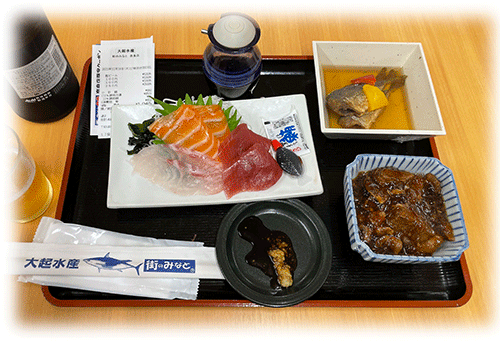| Please access the following URL if you want to secure using SSL. All pages in the site will be secure pages. |
https://secure02.blue.shared-server.net/www.fish-food.co.jp/message english 1.2022.html |
Welcome to FISH FOOD TIMES
Jan. 2022 issue No.217

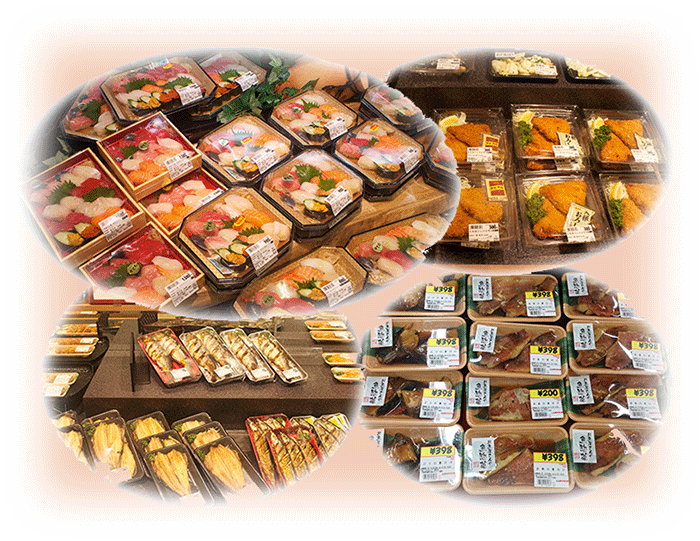
How the fisheries section survives
Energetic fish shop
The following text was written in the November issue of the month before last, and I'm sorry to repeat it, but I decided that it was necessary as an introductory part, so please read it. Of course, if you have already read it, you can skip it.
Then, I found an interesting shop, so I decided to go in. That was the "Daiki Fisheries Town Minato Nara Store" in the image below.
As shown in the image, there was a fish counter of Daiki Fisheries, and next to it, there was a restaurant selling fish side dishes called "Machi no Minato Shokudo". It may be a problem for me to enter the cafeteria without looking at the fish counter, but the aftereffects of the night before were trailing. It's a self-service system where you take your favorite side dish, pay for it, and bring it to the table yourself, but it's really cheap.
A medium bottle of beer usually costs 500 yen, but assorted sashimi costs 300 yen, pickled horse mackerel nanban is 100 yen, and boiled tuna costs 100 yen, for a total of 1,045 yen. The seasoning was delicious, and the two male employees were very friendly. In the end, I added two dishes of 100-yen side dish and two bottles of beer. And, really interestingly, something that could only be called a strange thing happened. A trio of men came right behind the table where I was sitting and started a business meeting without eating. I couldn't hear the content of the story, but I could only hear that the oldest and most prominent person was constantly repeating "700 yen, 700 yen ...". When one of the two employees called out to the bossy person, "Chairman ...!", He speculated that he was probably the chairman of Daiki Fisheries. Then, after the meeting of the three people was over and he disappeared from there, when I asked an elderly employee the truth of the guess, he was definitely Chairman Yasunobu Saeki himself. I described him as arrogant, but that doesn't mean he's arrogant, he's obviously the oldest, so he just looked awesome. In the September issue of FISH FOOD TIMES, the author questioned the direction of Toshin Sea Foods. And as far as I can see the direction of Daiki Fisheries, "Minato Nara store in town", I felt that there was something close to the direction I thought. In the Kanto region, I feel that I can agree with the direction of Kakujoe fish, but in the Kansai region, when I saw the Daiki Fisheries Nara store this time, I thought that there was something I could agree with. This is not this month's issue, but I would like to set a new theme on another occasion and mention it in depth. |
|---|
This store was newly opened as "Daiki Fisheries Queen's Market" (currently Machi no minato Nara store) in November 2000, and at the same time, the natural live fish Kaiten Sushi "Daisukiya" was opened. After that, in March 2006, the Daisukiya Nara store was remodeled into the Daiki Suisan Kaiten Sushi Nara store, and in August 2011, it was further expanded to open the Machi no minato cafeteria, which seems to have continued to this day.
Daiki Suisan Co., Ltd. started as a salted fish wholesale business in 1975 at the Sakai wholesale market in Sakai City, Osaka Prefecture. It started wholesale of fresh fish in 1980, and in 1988 opened the "Sakai Live Fish Distribution Center" along the circular line in Sakai City, Osaka Prefecture, and entered the fresh fish retail business. And in 1955, he opened "Sushi Land Daisukiya" in Tsurumi Ward, Osaka City.
Since then, it has opened various stores such as department store tenants, conveyor belt sushi stores, take-out sushi stores, seafood restaurants, and fresh fish retailers, and the Daiki Fisheries Group has recently sold 22.7 billion yen.
Daiki Fisheries is focusing on take-out sushi and conveyor belt sushi restaurants based on the image of a "fish shop" that handles fresh fish. Furthermore, it seems that the company is increasing its sales by expanding the range of products to fish side dishes and eat-ins, and opening them with interesting store names.
For example, the store name "Machi no minato" comes from the idea of creating "Minato" where delicious fish gather in the city, and it is unique that it does not use the old name "fresh fish store". Originally, "Machi no minato" should have been aimed at retailing fresh fish in the city, but when checking the recent store openings, it seems that there are many small stores centered on takeout in the downtown area. This also shows a strategy that utilizes the fresh image of a fresh fish store as it is.
Since starting as a wholesaler of salt and dried fish in 1975, Daiki Fisheries has changed its name at a speed that can be called phantasmagoric. And they are not very particular about the style of opening stores, and they feel that they are willing to change. However, it seems that the image of "a fish shop dealing with fresh fish" is cherished as a basic pillar.
It is presumed that the highest sales of Daiki Fisheries products are probably the sushi products including take-out sushi and conveyor belt sushi. They are cheaper than a full-fledged conventional sushi restaurant, and the product image is sushi derived from "fresh fish that fish shops handle". As a matter of fact, there is currently no way to know how much such fish-based sushi from Daiki Fisheries is used. However, rather than simply selling fish shop products as raw materials, they are focusing on selling ready-to-eat products such as high-value-added sushi and fish side dishes while valuing the fresh image of the fish shop. That is probably the basis for shaping the "Energetic fish shop's Daiki Fisheries," which has been actively opening stores based in Kansai.
Daiki Fisheries in the west, Kakujyo Gyorui in the east
If the representative of the Energetic fish shop in Kansai is Daiki Fisheries, Kakujyo Gyorui will be the first in the eastern Kanto region. The author was asked for the first manuscript in the September 2012 issue of the September 2012 issue by Syogyokai, which closed its curtain on a long history two years ago, with the theme of "Counterattack! Fish Revolution". I wrote "Face-to-face sales of round fish and strengthening of cooking services" and the subtitle "200% compared to the previous year realized by the introduction of refurbishment". The article was published over four pages, but up to the previous page, four pages introduced the Kakujyo Gyorui Hino store as an advanced example. With that kind of connection, I've been paying attention to Kakujyo Gyorui since then.
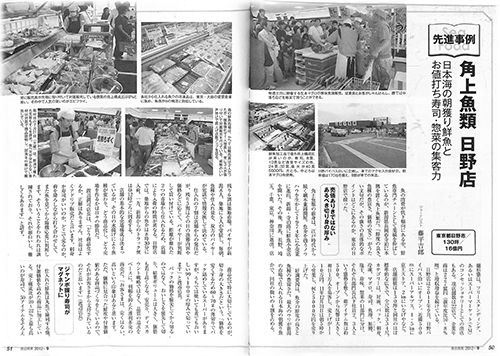
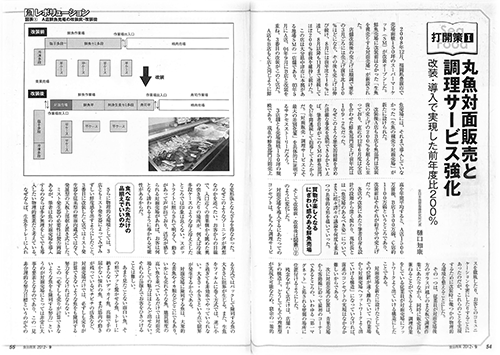
As for Kakujyo Gyorui, it is famous because it has been taken up a lot in the media, so it seems that the author does not need to describe it in detail now, so I will focus on only the necessary points here.
At the time of 2012, I didn't know that Kakujyo Gyorui would be published in the same September issue. And I read articles about Kakujyo Gyorui other than the ones I wrote, and I was often surprised by the contents. One is that a fish shop with a store area of 429 square meters opens independently and sells 1.6 billion fish a year, and the second is that the loss rate is an order of magnitude lower at 0.6%. I was surprised at that.
I think the point that makes this possible is that the fresh fish that is shipped directly from Niigata Prefecture is not only fresh, but also the mechanism that sells out the purchased fish without waste is wonderful. For example, at the Hino store, we started by offering cooking services while selling round fish like a fish shop face-to-face, and not only commercializing fillets and sashimi, but also developing high-value-added fish shop sushi. Furthermore, if there is a miscalculated fish that is purchased but does not sell well, change it to a fish side dish in the in-store kitchen within the day so that the fish will be sold out as soon as possible. This "thorough selling method" is supposed to keep the fish fresh. This raises the store's reputation and, as a result, leads to a surprisingly low loss rate. It seems that the "thorough selling-out mechanism" is the true value that makes up Kakujyo Gyorui.
The annual sales of Kakujyo Gyorui Co., Ltd. was stated to be 22.8 billion yen in 2011 at that time, but as of the announcement of financial results in March 2021, the number of stores was 22 and the sales were 39.4 billion yen. It has increased by 173% in 10 years, so it can be said that it is a remarkable growth number for a fish shop company.
Sales trends and division composition ratio of supermarket fisheries section
Then, I wonder how much the fisheries section of supermarkets nationwide was making sales during the same period when Daiki Fisheries and Kakujyo Gyorui increased their sales in this way.
The following is the sales trend by supermarket division for about two years from November 2019 to the latest October 2021. The graph shows that the fresh food sector, including fisheries, was doing well except for the side dish section during the year from the beginning of 2020 to the beginning of 2021, benefiting from the Nesting demand caused by the corona disaster.
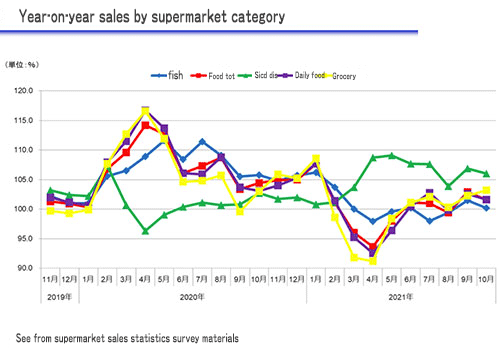
The following is a numerical graph showing the sales trends by supermarket division from January 2012 to October 2019.

Looking at the movement of both for 10 years, it can be judged from the graph that the fishery section during this period was struggling to increase sales.
The sales composition ratio of the fishery section decreased by 0.3% from 9.0% in April 2012 to 8.7% in April 2021, the meat section increased by 1.8 points from 10.0% to 11.8%, and the side dish section also increased by 8.9%. It increased by 1.4 points from to 10.3%.
Most recently announced figures The sales composition ratio of the fishery section in October 2021 has dropped to 8.4%.
Prosperity of fish shop companies and decline trend of supermarket fishery section
Why did this happen ... The declining trend of supermarket fishery section sales cannot be stopped, and I wonder how far it will fall in the future. It is easy to dismiss the cause by simply saying "Japanese fish away", but on the other hand, if you know the fact that fisheries such as Daiki Fisheries and Kakujyo Gyorui are extremely prosperous. How should we explain that?
The biggest factor is
As a result of over-promoting "efficiency, rationalization, labor saving"
I think it is.
This is because each supermarket company has cut one after another the measures that customers are pleased with in order to realize "efficiency, rationalization, and labor saving." Due to the nature of the product, not only labor saving was done to improve efficiency in the fishery section, which requires a lot of trouble. Furthermore, in order to satisfy the various demands of higher-ranking employees, the time-consuming face-to-face naked sales of round fish were first removed from the sales floor. As a result, the old-fashioned naked selling of raw fish has disappeared. In this way, the fish counter, which at first glance seems to be very rationalized, is a typical example.
Furthermore, the fish counter is a customer who says, "What do customers want from the fish section, what kind of fish they want, what kind of fish they are having trouble with, what kind of fish they want to know, and how to handle fish". Is not trying to meet the potential needs that are not mentioned. This is because there are no people in the fishery workshop, and the number of fish counters that say, "I can't do anything that is bothersome," has increased.
And the supermarket owners who take such a route set up a factory called a process center to surely realize this, and the sashimi that was made at that factory the day before and the surface was dried over time was lined up in the fish section the next day, and they Is pleased that the store was able to save labor. It is unlikely that customers will be willing to buy such unsavory sashimi as repeaters over and over again, and you should be able to see if the supermarket fish section that does this is highly valued by customers.
In the past, the author was asked to write a manuscript on the theme of "Counterattack! Fish Revolution" in the September 2012 issue of the monthly food and commercial magazine. The author mentioned above that he wrote the title "Face-to-face sales of round fish and strengthening of cooking services" and the subtitle "200% compared to the previous year realized by the introduction of refurbishment". Of course, the main idea was that "face-to-face sales of round fish and cooking services are important at the fish counter." However, under the same theme, the completely opposite logical development to the author was described in the same September issue as follows.
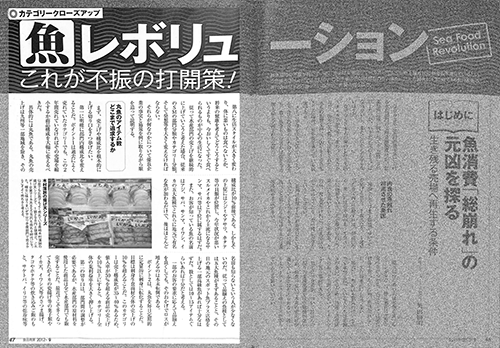
Among these, as for the assortment of round fish in the fish section, it is sufficient to have five major fish species such as horse mackerel, mackerel, saury, sardine, and squid, and 10 to 15 fish species are sufficient. It was stated that strengthening the assortment of tempura, fish retort, and salted and dried products would increase the sales and composition ratio of the fishery sector. When I read the opposite sentence to the author's idea, I was amazed that "even if you do this, the sales of fish will never increase".
This was written by a fish consultant, but the fishery department of a supermarket under the guidance of such a consultant must have been the first to suffer from sluggish sales. Then, the fishery companies such as Daiki fisheries and Kakujyo gyorui, which had become large-scale and commercialized, saw the supermarkets that developed such an unfortunate fish section and were delighted to say, "Go that way!"
Especially in the Kanto area, in addition to Kakujyo gyorui, there are many leading fish shop companies such as Hokushin Fisheries and Uoriki. What helped the growth of such a company was the fishery section of the supermarket, which had reduced the appeal of the fish section by strengthening efficiency, rationalization, and labor saving. And it is the owner of the supermarket who has created such an unattractive fish section in the store.
Footsteps of the revival of the fish shop
A long time ago, when I was still starting to throw myself into the world of fish as a fledgling newcomer, the supermarket industry was booming and had the momentum to drop flying birds. And the fish shops that had been located all over Japan as industry stores were overwhelmed by the power of cheap prices from the fishery section of the supermarket. And, the fish shops of the family business that were in the area on the scale of such a daddy mama store were weeded out one after another and disappeared.
Nearly half a century has passed since then, and now fish stores as a family business have become so rare that they are rarely found in the area, and when consumers buy fish, they have no choice but to go to the fish section of the supermarket. However, it was the fishery companies such as Daiki Fisheries and Kakujyo gyorui that stopped the movement. Taking advantage of the sloppy situation of the fish section of the supermarket, they are now steadily stealing the share of marine products sales from the supermarket, and the footsteps of the revival of the fish shop are gradually being heard.
Now let's think about how the super fishery sector can overcome the current unstoppable decline. As an example, I would like to give a concrete example in which the author has guided and greatly improved the figures in the fisheries sector. The fishery section sales of the company have increased to 200% in the 10 years since the author started teaching, and the composition ratio by department has increased from about 6% to 10%. Originally, the composition ratio by department of 6% is too low, so it may seem unhelpful, but that view is wrong. The region has a deep-rooted carnivorous culture, and competitors have a similar low-level fishery sector composition, with a figure of 10% being unusual.
Actually, some of the product images of the fish section of that company are used in the opening image of this month's issue, but let's hide the specific company name and let's call it company A. The contract for fishery section guidance, which had been ongoing for 13 years, was lifted in February last year and is now irrelevant. It's good that the fish section of company A became being at a glance in the area, but I can't say that I did what I should have done, and I feel like I'm halfway through. However, there is no doubt that there is a sense of accomplishment to some extent, and after all, there is still a strong sense of attachment that accompanies the emotional transfer to those who have been in contact for a long time.
There is a common direction for both company A, which the author was instructing, and Daiki Fisheries and Kakujyo gyorui, which are the protagonists of this month's issue.
that is,
Strengthen the product and sales capabilities of fish shop sushi and fish side dishes
Among them, the presence of fish shop sushi is large, and it is a fact that not only company A but also the company that I am currently instructing is ranked number one in the sales composition ratio by class in the fishery section. Actually, when the author started the instruction of company A, the fish shop sushi was doing small experimental level efforts at one store, but the fish shop sushi was strengthened by expanding it to all stores. That was the basis for the increase in sales of the fishery section.
Just by increasing the number of stores that handle the fish shop sushi, the limit of sales increase will surely come. Therefore, in order to increase the sales of the fish shop sushi, we decided to steer to high-quality, high-priced routes, mainly raw bluefin tuna, instead of low-priced routes that are easy to buy. As a result, the composition ratio in the fishery section of the fish shop sushi product class did not fall below 20%, and it grew up as a signboard product with 25% or more being normal and approaching 30% depending on the month.
Daiki Fisheries and Kakujyo gyorui should have similar historical backgrounds, and they probably both speculate that the fish shop sushi is the number one seller. And the author feels that there is a really strange phenomenon, especially in the Kanto region and the eastern Japan region. That is, there is no company in the supermarket that strengthens the fish shop sushi and makes it a signboard.
Every time I visit a supermarket in the area of eastern Japan, I often get discouraged, saying, "Why are you still satisfied with the level of selling side dish sushi?" The owner of such a supermarket may think that "side dish sushi is enough ...", but clearly does not understand that "fish shop sushi and side dish sushi are different things".
The way of putting effort into the fish shop sushi of Daiki Fisheries is not halfway, and this is exactly the way Daiki Fisheries lives. Looking at the recent opening of Daiki Fisheries, the author feels that he is making good use of the consumer's image that "sushi offered by fisheries is fresh and cheap." Whether it's conveyor belt sushi or take-out sushi, the "fishery image" of Daiki "fishery" is important. It is understood from the fact that there are many conveyor belt sushi restaurants that are prosperous even if the contents are no big deal, just because "fish shops run sushi shops" in various parts of Japan.
To the self-contained fish department
Even if it is understandable that strengthening fish shop sushi will increase sales in the fishery section, there are timid supermarket owners who cannot make it concrete. I presume that it is because they are afraid of the loss rate resulting from price cuts and disposal of sushi products. Certainly, it is not uncommon for sushi products to have a loss rate of 20% if they are not good at it, and I think that some supermarket owners may have had the bitter experience of not being able to do business with this.
However, it should be difficult to increase the sales of the store itself with a bearish idea that is just afraid of such losses. As a basic stance, there should be no corporate development unless we boldly challenge things and think about and implement ways to cover the risks in some way.
For example, when I think about why Daiki Fisheries and Kakujyo gyorui are growing so much while dealing with fish shop sushi, I think that there is a "self-contained fish section".
A self-contained fish section is
"Fish section with know-how to convert all purchased fish into money"
The surprising figure of Kakujyo gyorui's loss rate of 0.6% even at that time 10 years ago may have been possible because the purchased fish could be sold out as a fish side dish at the end. I don't know the loss rate of Daiki Fisheries, but since they are focusing on fish side dishes at "Machi no Minato Shokudo" etc., there is no doubt that they have the know-how to sell out the purchased fish.
The field of fish as food, which is to "bake, boil, and fry" fish, is an immature world for the author, and I do not have the know-how to teach it very much. However, the coping method for the purpose of using up the purchased fish is not the advanced cooking knowledge required by professional cooks, such as zuke, pickled nanban, tatsutaage, fried, and boiled. I think that the knowledge that is an extension of home cooking is sufficient for them.
Now, fish shop sushi is an era when the use of raw bluefin tuna has become a differentiating weapon. If you're still trying to roll out fish shop sushi with frozen bigeye tuna and yellowfin tuna, you should be aware that it won't win the competition from the beginning. Even the raw bluefin tuna has a supermarket fishery section that can't be handled because the purchase price is high and the loss rate may increase. However, in such a bearish situation, sales will continue to decline, and management decisions may be made to leave the fish section to tenants.
Let me introduce one example that even if you use raw bluefin tuna, which has a high purchase price, if you acquire the know-how to sell out all of them, the evaluation of the fish section will increase steadily. It is a supermarket with a sales floor area of 924㎡, which is the 8th year since the author started teaching. Most recently, according to the information I received from the fishery manager there, the total number of orders for special order dishes of assorted sushi from 5,800 yen to 9,800 yen during the New Year holidays exceeded 200 units.
This is not the number of sushi products sold in stores, but the number of purely expensive special order dishes of assorted sushi products. Eight years ago, this company also took out the frozen sushi dish of yellowfin tuna in a vacuum bag, put it on a rice ball, and sold "Nose sushi that is not nigiri" called fish shop sushi. However, now that sushi products based on raw bluefin tuna have been highly evaluated by customers, they have become overwhelmingly competitive in the region, and sales are growing and prospering.
By the way, has the sales of existing stores in your fishery section increased or declined over the last 10 years? Please do not make irresponsible excuses such as the Japanese people leaving the fish for the reason for the sluggish sales. As mentioned above, there are companies that continue to increase sales not only in Daiki Fisheries and Kakujyo gyorui, but also in the fisheries section of ordinary supermarkets. If you devise a way of thinking and methods for the fish section, you can increase sales.
I wish you all the best of luck in what efforts this year will bring to increase sales in the fisheries section.
| Please access the following URL if you want to secure using SSL. All pages in the site will be secure pages. |
https://secure02.blue.shared-server.net/www.fish-food.co.jp/message english 1.2022.html |
An opinion and the communication are to iinfo@fish food times
Date of updating 1 Jan. 2022


